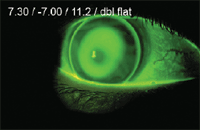Complex cornea calls for simple solutions
New gas permeable contact lens designs offer a wealth of opportunity to provide solutions for patients who have reduced vision caused by corneal distortions.

Key Points


"Most contact lenses are designed to fit a 'normal' type of corneal topography," Dr. Watanabe said. "When patients have abnormal corneal shapes, they can be a challenge to fit."
A normal cornea is steepest or most curved in the center, and gradually becomes flatter toward the periphery. It tends to be fairly symmetrical in the top half and the bottom half, and to have smooth and predictable changes in curvature.
A complex cornea can deviate from normal in a number of ways. It could be more curved in the center and flatter in the periphery, or have an extreme change from center to edge. In patients who have keratoconus, the central portion of the cornea is very steeply curved, and flattens out very rapidly.

Patients who have had ocular surgery, such as a corneal transplant, may have a totally distorted, asymmetric cornea. Eyes that have experienced a trauma can have a number of irregularities across the entire corneal surface.
Strategies and tactics
Whatever the reason for the patient's complex cornea, the first step toward helping them is to identify patients who are not obtaining their best vision or comfort with a common contact lens design, Dr. Byrnes said. Then you can improve their ability to see comfortably and clearly with lenses that are stable on their eyes.
"When you endeavor to correct patients' vision, you must look at what will give them the best visual outcome, the best comfort outcome, and maintain the best physiological compatibility with the eye," Dr. Byrnes said. "Know your options, know where to start, and know when to go to the next level."
New developments in gas permeable lenses include limbal and scleral lenses. However, many optometrists aren't familiar or comfortable with these larger lenses, according to Dr. Byrnes.
"The newest lenses we have fit the limbus, and not many practitioners have experience with those," Dr. Byrnes said. "Those practitioners have an opportunity to select one of those designs, learn how to fit it, and then be able to offer it to patients who aren't succeeding with the smaller lens designs, or patients who don't have stable vision with a corneal design lens."
Other candidates for these larger lenses are patients who can see well but can't turn their eyes to the side without dislodging the lenses and patients who are wearing piggyback lenses.